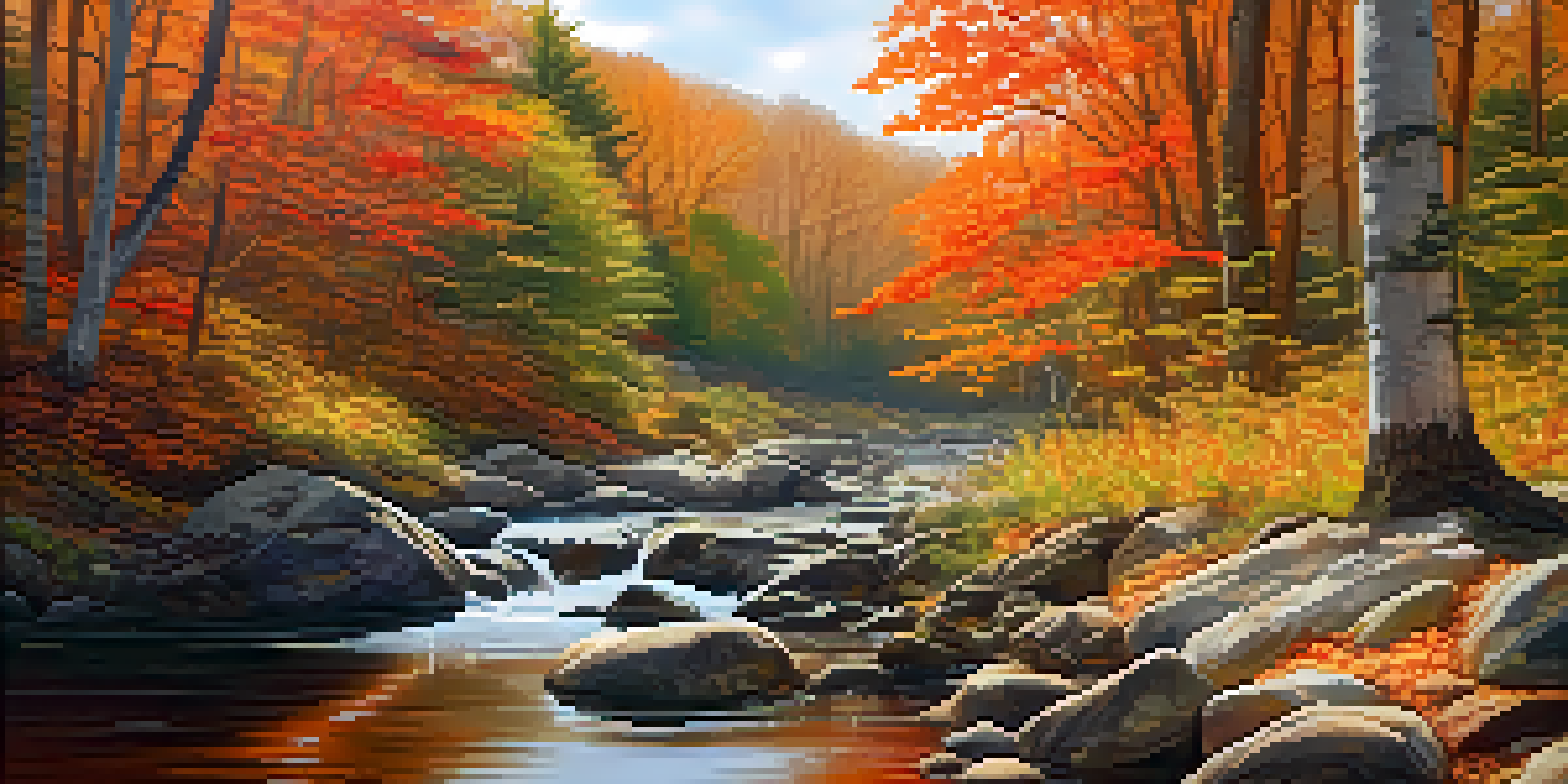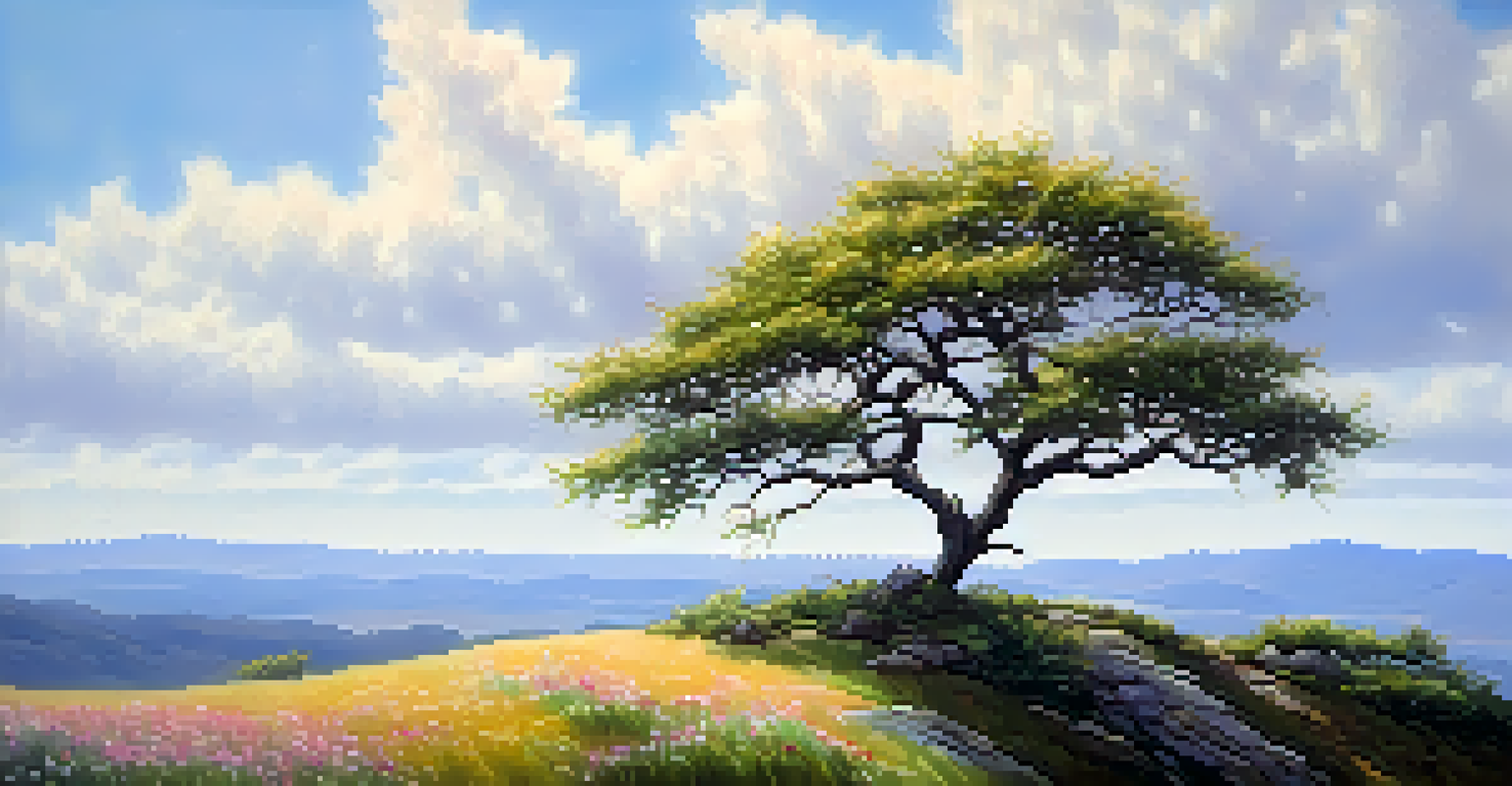Emerson and Thoreau: Influences on American Painting

Transcendentalism: The Heart of Their Influence
Ralph Waldo Emerson and Henry David Thoreau were pivotal figures in the Transcendentalist movement, which emphasized the importance of nature and individual intuition. Their ideas encouraged artists to seek inspiration from the natural world, seeing beauty in simplicity and the unrefined. This philosophy not only shaped literature but also had a profound effect on American painting during the 19th century. Artists began to explore themes of nature and self-reliance, mirroring the transcendentalist ethos.
In the woods, we return to reason and faith.
Transcendentalism urged painters to step outside traditional European influences and embrace the American landscape. This shift allowed artists to capture the essence of their surroundings, from the vastness of the Hudson River Valley to the serene beauty of New England's forests. The movement inspired painters to depict scenes that resonated with the American spirit, aligning with Emerson's belief in the connection between nature and the human soul. As a result, many artists found a sense of purpose in showcasing the beauty of their homeland.
Moreover, the philosophy promoted a sense of spirituality in art, encouraging artists to express their inner thoughts and feelings through their work. This led to an emphasis on personal interpretation and emotional resonance, which became hallmarks of American painting. As Emerson and Thoreau championed the idea of finding truth in nature, painters began to create works that were not just visually stunning but also deeply reflective of their personal experiences.
Nature as a Central Theme in American Art
The natural world played a crucial role in the works of many American painters influenced by Emerson and Thoreau. Artists like Thomas Cole and Frederic Edwin Church captured breathtaking landscapes that celebrated the majesty of nature. Their paintings often conveyed a sense of reverence for the environment, echoing Thoreau's observations in 'Walden,' where he emphasized living simply and harmoniously with nature. This connection to the land became a cornerstone of American artistic identity.

In addition, the Hudson River School, a group of 19th-century landscape painters, embodied the transcendentalist vision through their focus on American scenery. They painted grand vistas that not only showcased the beauty of the land but also reflected the philosophical ideas of Emerson and Thoreau. By emphasizing light, atmosphere, and detail, these artists created works that invited viewers to connect emotionally with the landscapes, much like the writers did through their prose.
Transcendentalism Shapes American Art
The philosophies of Emerson and Thoreau significantly influenced American art by encouraging artists to draw inspiration from nature and emphasize individual expression.
This deep appreciation for nature in American painting also led to a broader movement toward realism and the exploration of local environments. As artists sought to depict their immediate surroundings, they began to highlight the unique characteristics of different regions. This shift marked a departure from European artistic norms, fostering a distinct American style that resonated with the values of self-discovery and connection to the land.
The Role of Individualism in Artistic Expression
Emerson and Thoreau's emphasis on individualism significantly shaped the way artists approached their work. They advocated for self-expression and encouraged individuals to trust their instincts, a message that resonated deeply within the art community. As a result, many painters began to develop unique styles that reflected their personal experiences and perspectives. This shift fostered a more diverse artistic landscape, where individual voices could flourish.
I took a walk in the woods and came out taller than the trees.
The idea of individualism also encouraged artists to break away from traditional techniques and explore new forms of expression. For instance, the use of color and brushwork became more experimental as artists sought to convey their emotions directly onto the canvas. This approach allowed for a greater range of interpretations and styles, reflecting the complexity of the human experience. In this way, Emerson and Thoreau's philosophies paved the way for a more vibrant and innovative art scene.
Furthermore, this focus on personal narrative in art helped to establish a sense of authenticity. Artists sought to depict their unique viewpoints and cultural backgrounds, leading to a richer tapestry of American art. By embracing their individuality, painters were able to create works that not only resonated with their own truths but also connected with audiences on a deeper level, echoing the transcendentalist belief in the power of personal insight.
Aesthetic Reactions to Industrialization
The rapid industrialization of America in the 19th century prompted artists influenced by Emerson and Thoreau to react against the encroaching urban landscape. As cities grew and nature was increasingly threatened, painters began to portray themes of nature as a refuge from the chaos of modern life. This response was not only a reflection of their love for the natural world but also a critique of the consequences of industrial progress, highlighting the importance of preserving the environment.
Artists like Albert Bierstadt and Thomas Hill depicted expansive landscapes that served as a reminder of the beauty and tranquility found in nature. Their works often contrasted the serenity of natural scenes with the harsh realities of industrial life. By showcasing untouched wilderness, these painters aimed to inspire a sense of appreciation for the natural world and encourage viewers to reflect on their relationship with the environment. This sentiment echoed Thoreau's warnings about the dangers of losing oneself in the rush of progress.
Nature as Artistic Refuge
As industrialization threatened natural landscapes, artists depicted nature as a sanctuary, critiquing urban encroachment while promoting environmental conservation.
Moreover, this aesthetic reaction helped to foster a conservationist movement among artists and intellectuals. As the beauty of the American landscape became a central focus in art, it also sparked a desire to protect these natural spaces from industrial exploitation. This movement laid the groundwork for future environmentalism, illustrating how the influences of Emerson and Thoreau extended far beyond the canvas and into the broader cultural consciousness.
Symbolism in American Painting: A Reflection of Ideals
Emerson and Thoreau's philosophies also encouraged the use of symbolism in American painting, allowing artists to convey deeper meanings through their work. Symbolism can be seen in the way artists depicted elements of nature, such as trees or water, as representations of growth, purity, or the passage of time. This approach allowed for a richer interpretation of art, aligning closely with the transcendentalist belief in the interconnectedness of all things.
For example, the use of the American flag in paintings not only represented national pride but also symbolized the ideals of freedom and individuality championed by both philosophers. Artists like Edward Hicks incorporated symbols in their works to communicate messages of harmony and unity, reinforcing the transcendentalist vision of a connected society. This layering of meaning added depth to the artwork and invited viewers to engage with it on multiple levels.
Furthermore, symbolism in art became a tool for social commentary, enabling artists to address contemporary issues while remaining grounded in their transcendentalist beliefs. By using nature and other symbols as metaphors, painters could delve into complex themes of morality, spirituality, and human existence. This practice not only enriched the artistic landscape but also created a dialogue between the artist and the viewer, fostering a deeper understanding of the world around them.
Legacy of Emerson and Thoreau in Modern Art
The influences of Emerson and Thoreau on American painting extend far beyond the 19th century, leaving a lasting legacy in contemporary art. Many modern artists continue to draw inspiration from their writings and philosophies, exploring themes of nature, individuality, and the human experience. This enduring connection speaks to the timeless relevance of their ideas, as artists grapple with similar questions of identity and purpose in today's world.
In recent years, artists have increasingly turned to environmental themes, echoing Thoreau's call to protect and cherish the natural world. This resurgence reflects a growing awareness of climate issues and the need for sustainable practices. By channeling the transcendentalist spirit, contemporary artists are not only honoring the legacy of Emerson and Thoreau but also contributing to important conversations about the future of our planet.
Symbolism Enriches Artistic Meaning
Symbolism in American painting allowed artists to convey deeper meanings, reflecting transcendentalist ideals and fostering social commentary through their work.
Moreover, the emphasis on personal narrative and self-expression remains a cornerstone of modern artistic practice. Just as Emerson and Thoreau encouraged individuals to seek truth within themselves, contemporary artists often explore their own experiences and cultural backgrounds in their work. This ongoing dialogue between past and present ensures that the philosophies of these two thinkers continue to resonate within the artistic community, inspiring future generations of creators.
The Enduring Power of Nature in Art
Ultimately, the influence of Emerson and Thoreau on American painting underscores the enduring power of nature as a source of inspiration. Their writings remind us of the importance of connecting with the environment and the profound impact it can have on our creative expression. As artists continue to explore the relationship between humanity and the natural world, the principles established by these transcendentalists remain relevant and vital.
In a world that often prioritizes technology and urbanization, the call to appreciate and protect nature has never been more urgent. Artists play a crucial role in this dialogue, using their work to inspire appreciation and action. By channeling the philosophies of Emerson and Thoreau, they encourage viewers to reflect on their own connections to the earth and consider the implications of their choices.

As we look towards the future, the legacy of Emerson and Thoreau serves as a reminder that art can be a powerful tool for change. By celebrating the beauty of the natural world and advocating for its preservation, artists embody the spirit of transcendentalism, ensuring that the teachings of these influential thinkers continue to inspire and resonate in American culture and beyond.